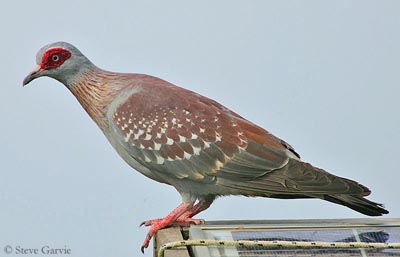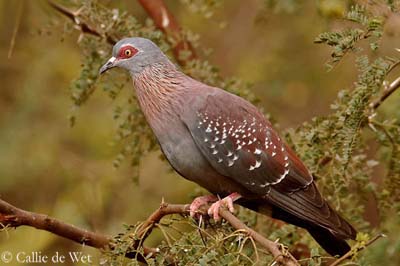
Speckled Pigeon
Columba guinea
Columbiforme Order – Columbidae Family
BIOMETRICS:
Length: 32 à 36 cm
Weight: 250 à 350 g
DESCRIPTION:
Speckled Pigeon is endemic to Africa.
Adult has blue-grey upperparts, and maroon mantle with light purplish reflections. On the wings, inner wing-coverts and tertials are maroon, slightly marked with grey. Outer wing-coverts are grey. We can see large part of wings boldly tipped with numerous white triangles, becoming narrow white fringe on outer greater coverts. Flight feathers are dull grey-brown.
Back to rump is pale grey, ending into darker grey uppertail coverts. All feathers show pale grey tips. Tail is dark grey with broad black terminal band.
DIET:
Speckled Pigeon feeds mainly on seeds and cultivated grains.
PROTECTION / THREATS / STATUS:
Speckled Pigeon is common throughout most of its range. Populations are stable or increasing.
Fr: Pigeon roussard
Esp : Paloma de Guinea
Ital : Colomba della Guinea
Nd : Gespikkelde Duif
Russe : Крапчатый голубь
Photographers :
Callie de Wet
GALLERY
Steve Garvie
RAINBIRDER Photo galleries
Text by Nicole Bouglouan
Sources :
HANDBOOK OF THE BIRDS OF THE WORLD vol 4 by Josep del Hoyo-Andrew Elliott-Jordi Sargatal - Lynx Edicions - ISBN: 8487334229
BIRDS OF AFRICA SOUTH OF THE SAHARA by Ian Sinclair and Peter Ryan - Princeton University Press Princeton and Oxford - ISBN: 0691118159
PIGEONS AND DOVES by David Gibbs, Eustace Barnes and John Cox - Pica Press Sussex - ISBN: 1873403607
Wikipedia (Wikipedia, The Free Encyclopedia)

Underparts are blue-grey, paler on belly. Underwings are pale grey, with blackish undersides of primaries and secondaries. Undertail feathers are grey with pale tips. Undertail is blackish with pale grey bases in outer feathers.
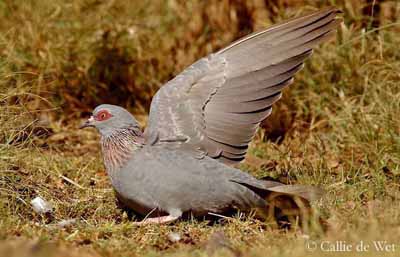
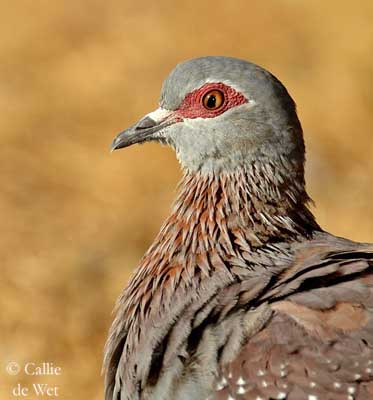
Head is blue-grey. Chin is whitish and throat is pale blue-grey. Upper breast and neck are rusty-red with blue-grey tips to elongated feathers. Lower breast is blue-grey.
We can see a conspicuous elliptical bare red skin patch around the eye, from lores to ear coverts. Eyes are golden yellow. Bill is blackish with whitish cere. Legs and feet are purplish-pink.
Both sexes are similar.
Juvenile is browner and duller than adults. Orbital skin is browner too.
We find three other races:
Columba guinea phaeonotus, from NE Zimbabwe and SW Angola to The Cape. This one has darker grey head and rump. White triangular spots on wings are smaller. This pigeon is slightly larger.
And two more: Columba guinea guinea and Columba guinea rufina.
Similar species:
African Olive Pigeon (Columba arquatrix) from Ethiopia to The Cape. It has the same dark maroon upperparts and white spots, but it has yellow orbital skin, bill and legs.
Feral Pigeon (Columba livia) from southern edges of Sahara and Sahel region. Some varieties may be similar in plumage, but they often lack the red orbital skin.
VOICE: SOUNDS BY XENO-CANTO
Speckled Pigeon gives loud, explosive cooing “doo doo doo” or “whu whu whu whu-WHU” uttered with force and volume.
HABITAT:
Speckled Pigeon lives mainly in open country, farmland, savannahs, grasslands, with nearby trees such as palms or baobabs. It is also found in urban areas where it is often seen on roof tops. It may lives from sea-level to 3,000 metres of elevation.
RANGE:
Speckled Pigeon is resident in most parts of Africa south of the Sahara. It is scarcer in central parts.
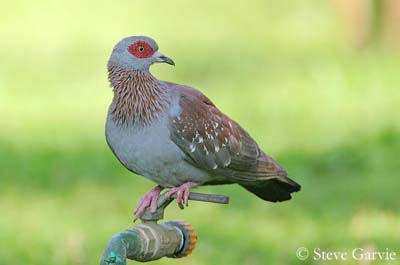
BEHAVIOUR:
Speckled Pigeon gather in large numbers where grain or groundnuts are abundant. It is very gregarious and flocks may reach several hundreds of birds, mixed with other pigeon’s species and doves. They roost on cliffs, buildings and tall trees.
Speckled Pigeon walks and runs easily on the ground.
Speckled Pigeon breeds year-round in most parts of its range. When pair is formed, male attracts its mate into potential nest-site by some postures such as crouching down, lowering the head and twitching its wings. At the same time, it utters vocalizes.
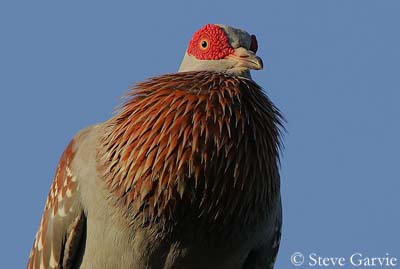
Male also performs bowing display and flight display. It flies up with clapping wings, then, it performs a glide on stiff wings slightly below body level. It can repeat this flight display several times.
FLIGHT:
Speckled Pigeon has strong flight, and it often flies very high in the sky. It has fast flight with regular wing beats. In flight, pale grey rump contrasts with darker upperparts.
REPRODUCTION:
Speckled pigeon breeds mainly in latter half of dry season. It may nest singly or in colonies. Nest is situated on a cliff, in tree or in building. We can find various kinds of constructions, such as scrapes, or loose cup with a few twigs, or even large platform of twigs. Interior is lined with small twigs or grass.
Female lays 1 to 3 white eggs. Incubation lasts about 14 to 18 days, shared by both parents. Chicks are fed by both adults, with crop-milk, as other Columbidae.
Several days later, young begin to eat small pieces of food brought at nest by adults. They fledge about 20 to 25 days after hatching.
